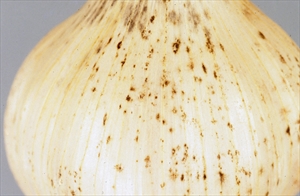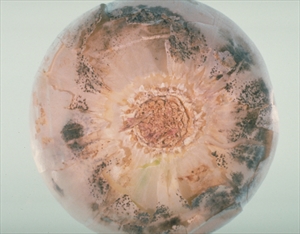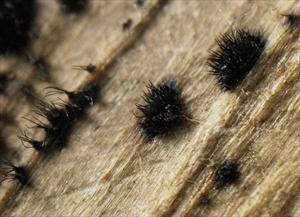Smudge of onion bulbs, anthracnose of onions
Pacific Pests, Pathogens, Weeds & Pesticides - Online edition
Pacific Pests, Pathogens, Weeds & Pesticides
Onion smudge (186)
Colletotrichum circinans
Asia, Africa, North and South America, the Caribbean, Europe, Oceania. It is recorded from Australia, Federated States of Micronesia, Fiji, French Polynesia, New Zealand, Palau, Papua New Guinea, Solomon Islands, and Vanuatu.
Onion, leek, Welsh onion (Japanese bunching onion), Chinese chive, shallot.
The disease affects one or two outer dry leaves of the bulb, especially the lower parts. The outer leaves are known as 'wrapper scales'. Smudge also affects the neck of the bulb. Small, round dark spots develop which may be scattered over the surface of the bulb (Photo 1), in diffuse (not well defined) patches (Photo 2), or more frequently in concentric rings 1-2 diameter. The spots contain cream spore masses and stiff long black hairs characteristic of the fungus, and these can be seen using a hand lens (Photo 3).
More extensive rots develop in the inner fleshy leaves if the onions are harvested during wet weather and stored under moist conditions above 20°C. First, the bulbs shrink, and then the leaves become susceptible to rots caused by other fungi
On leaves, purplish elongated spots develop becoming black as the fruiting structures form. A blight is possible in warm, wet climates. On seedlings, the fungus can cause a serious damping-off disease (see Fact Sheet no. 47).
The fungus survives in the soil on the remains of onion leaves, producing spores to infect the next crop. Damp soil and soil temperatures above 20°C are best for rapid development of the disease. Water is also needed for spore germination. Spread of the fungus occurs when spores, either on the outside surface of the bulbs or as infections of the scale leaves, are moved in wind-blown rain.
The main damage is the infection of the outer scale leaves of the bulb of white onions, leeks and shallots; this is unsightly and reduces market value. If bulbs are stored for a long time, smudge causes the scale leaves to shrink, the bulbs to sprout prematurely, and to become susceptible to other storage rots.
Leaf infections can be serious occasionally, although rare in Pacific island countries. They are reported from Solomon Islands.
Damping-off occurs on seedlings and can lead to total loss.
Look for dark-green to black spots in patches on the outer scale leaves of bulbs. Most often the spots and patches are at the base, or follow the lines of the vascular tissues up to the neck. Look for purplish to black long spots on the leaves with fungal fruiting bodies.
Other fungi attack onion bulbs and produce similar symptoms, such as purple blotch, Alternaria porri (see Fact Sheet no. 151). Use a hand lens and look for the long black hairs that distinguish smudge from purple blotch (Photo 3).
CULTURAL CONTROL
Before planting:
- Use a 2-3-year rotation between successive crops of onion and its relatives on the same land.
- Choose land with good drainage.
- Ensure that seed is clean and that transplants are healthy.
During growth:
- Do not harvest crops during wet weather.
After harvest:
- If infected bulbs are seen at harvest keep them separate from those that appear healthy.
- Dry bulbs after harvest and before storage and marketing. Place the bulbs in a dry windy place under sunlight for a few days. When cured, store under dry, cool conditions.
RESISTANT VARIETIES
Varieties of onions with coloured outer scale leaves have resistance to smudge due to the presence of phenolic compounds that have antifungal properties.
CHEMICAL CONTROL
First priority should be to control the disease using cultural methods and/or resistant varieties. If fungicides are needed and considered economic, use mancozeb or chlorothalonil.
____________________
When using a pesticide, always wear protective clothing and follow the instructions on the product label, such as dosage, timing of application, and pre-harvest interval. Recommendations will vary with the crop and system of cultivation. Expert advice on the most appropriate pesticide to use should always be sought from local agricultural authorities.
AUTHOR Grahame Jackson
Information from Diseases of vegetable crops in Australia (2010). Editors, Denis Persley, et al. CSIRO Publishing; and CABI (2021) Onion Smudge (Colletotrichum circinans) Plantwise Knowledge Bank. (http://www.plantwise.org/KnowledgeBank/Datasheet.aspx?dsid=14897); and from Rollins J (2014) Colletotrichum circinans. BugwoodWiki. (http://www.plantwise.org/KnowledgeBank/Datasheet.aspx?dsid=14897). Photo 1 Gerald Holmes, California Polytechnic State University at San Luis Obispo, Bugwood.org. Photo 2 Diseases of vegetable crops in Australia (2010). Editors, Denis Persley, et al. CSIRO Publishing. Photo 3 Cesar Calderon, USDA APHIS PPQ, Bugwood.org.
Produced with support from the Australian Centre for International Agricultural Research under project PC/2010/090: Strengthening integrated crop management research in the Pacific Islands in support of sustainable intensification of high-value crop production, implemented by the University of Queensland and the Secretariat of the Pacific Community.






